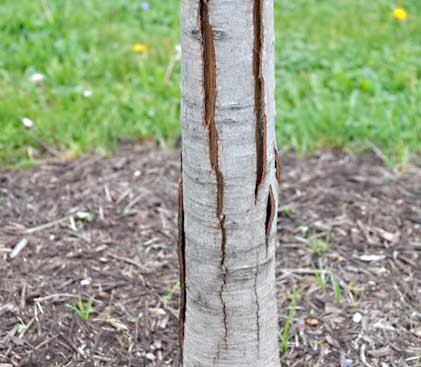Bark cracks can have several causes.
Bark cracks may have several causes:
Frost crack: at night, water freezes in the bark, with the pressure of the frozen water (ice takes up more space than water) causing the bark to burst open. A tree with a frost crack is in no immediate danger and may live for several years.
Sunburn and frost cracking of trees can occur in any winter. Damage is not immediately visible. Sunken, discolored bark, with subsequent cracking and peeling of the bark, usually does not become apparent until spring. The cause of sun frost cracks are strongly fluctuating temperatures, ranging from just above 0°C to below -10°C on days of bright sunshine and nights with temperatures well below freezing. The sun’s heat makes the bark grow; the subsequent drop in temperature (particularly at night) leads to rapid freezing and death of the developing inner bark tissues.
Torsion: this is especially common in fruit trees (apples, pears, plums) whose branches are full of fruit. The branches can become so heavy that the branch cracks from the trunk or vertical (torsion) cracks in the trunk.
Lightning strike: often then, not only is there a crack, but the trunk (usually of large, mature trees) is completely cleaved.
Sun: some trees (lime tree, beech) are sensitive to sunburn, causing the bark to crack. Sunburn is caused by a combination of strong sun, high temperature and drought stress of the tree, causing the temperature of the bark rising too much (> 40°C) and tissue damage occurs.
Bark cracks are rarely fatal to trees but could lead to additional damage caused by invading decay organisms. Trees with thin bark are susceptible to cracking.
Control
Not all cracks need to be treated: growth cracks are generally harmless. Really open cracked bark may be treated with wound balm. Cracks due to sunburn should be scratched clean and treated with wound balm.
Prevention
Sunburn at a lime tree and beech may be prevented by wrapping the trunk with burlap at planting. This should also be done if pruning suddenly exposed part of the trunk to the summer sun.

